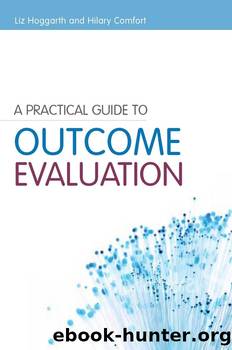A Practical Guide to Outcome Evaluation by Liz Hoggarth Hilary Comfort

Author:Liz Hoggarth, Hilary Comfort [Liz Hoggarth, Hilary Comfort]
Language: eng
Format: epub
Tags: Social Science, Social Work, Business & Economics, Project Management
ISBN: 9781849050371
Google: t1ISBQAAQBAJ
Publisher: Jessica Kingsley Publishers
Published: 2010-01-15T04:28:41+00:00
Practice example
Risk assessment scales are frequently used to assist in nursing patients who may develop pressure ulcers. These wounds caused by immobility present huge problems. If pressure is placed on a part of the body, blood circulation is reduced. This is not a problem in healthy people as they are constantly moving, even in sleep. In an unconscious or paralysed patient if the blood supply is reduced for long enough the tissue dies and rots away. The pressure ulcer is basically a hole in the body caused by the death of good tissue from pressure damage. About one in five hospital patients develops a pressure ulcer. Often these are trivial, merely a small break in the skin, but they can be extensive with gaping holes down to the bone. They can kill.
In order to evaluate methods of preventing and treating such ulcers, it is necessary to have indicators of their severity which everybody will understand. Because some patients are more at risk than others it is also necessary to have some way of taking risks into account when comparing the outcomes for patients. Accurate indicators of risk will also help nurses to prioritise those with the greatest likelihood of developing ulcers.
Early research showed that patients who moved during sleep at least twenty times per night were less likely to develop pressure ulcers than those who moved less. Mobility was thus one factor, but in 1962 scores for several other factors, incontinence, activity, mental state and physical condition, were added to mobility to create the first pressure-ulcer risk assessment scale. In the UK, hospitals now tend to use the Waterlow score. (Waterlow 1991) This consists of eleven main sub-scores with various ranges, including the factor of being terminally ill with cancer. The sub-scores are added together to give an overall risk score.
Assessment of patients for the risk of developing pressure ulcers on admission to hospitals in the UK is now common. The idea is that if we can determine who is at high risk â because we know the indicators â we can reduce the possibility of pressure ulcers. A frail elderly patient who has a fracture of the neck of the femur (broken hip) is likely to develop an ulcer because of their immobility. A twenty-year-old admitted for removal of wisdom teeth is pretty unlikely to have this problem. So, if we have one special bed which reduces the pressure on the patient, we know which patient should have it. We may want to put other special measures in place. For example, elderly patients often have poor nutrition so we may refer the fractured hip patient to the dietician. This is especially important as poorly fed patients tend to develop pressure ulcers more quickly. A high Waterlow score shows a patient is at risk.
There are, however, problems with using this score. We might not have all the risk factors (for example, low blood protein is associated with pressure ulcers). Some of the alleged risk factors may not be a problem for some patients or may be insignificant.
Download
This site does not store any files on its server. We only index and link to content provided by other sites. Please contact the content providers to delete copyright contents if any and email us, we'll remove relevant links or contents immediately.
Hit Refresh by Satya Nadella(9041)
The Compound Effect by Darren Hardy(8818)
Change Your Questions, Change Your Life by Marilee Adams(7639)
Nudge - Improving Decisions about Health, Wealth, and Happiness by Thaler Sunstein(7622)
The Black Swan by Nassim Nicholas Taleb(7016)
Deep Work by Cal Newport(6888)
Daring Greatly by Brene Brown(6451)
Rich Dad Poor Dad by Robert T. Kiyosaki(6414)
Principles: Life and Work by Ray Dalio(6226)
Playing to Win_ How Strategy Really Works by A.G. Lafley & Roger L. Martin(5937)
Man-made Catastrophes and Risk Information Concealment by Dmitry Chernov & Didier Sornette(5926)
Digital Minimalism by Cal Newport;(5667)
Big Magic: Creative Living Beyond Fear by Elizabeth Gilbert(5616)
The Myth of the Strong Leader by Archie Brown(5429)
The Slight Edge by Jeff Olson(5353)
Discipline Equals Freedom by Jocko Willink(5291)
The Motivation Myth by Jeff Haden(5158)
Stone's Rules by Roger Stone(5027)
The Laws of Human Nature by Robert Greene(5003)
